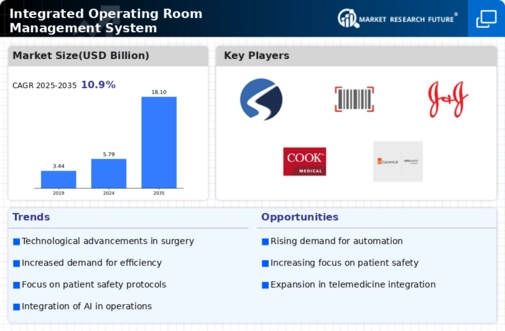Market Analysis
In-depth Analysis of Integrated Operating Room Management Systems Market Industry Landscape
The integrated operating room management system market is experiencing a significant surge in demand and growth, driven by various market dynamics. This market encompasses sophisticated technological solutions designed to streamline and optimize the workflow within operating rooms, facilitating better patient care and improved efficiency for healthcare providers. One key factor fueling the growth of this market is the increasing adoption of minimally invasive surgical procedures. These procedures require advanced equipment and technology to ensure precision and effectiveness, creating a substantial market opportunity for integrated operating room management systems.
Moreover, the rising prevalence of chronic diseases and the subsequent surge in surgical procedures worldwide are contributing to the expansion of this market. With the growing burden of diseases such as cardiovascular disorders, cancer, and orthopedic conditions, healthcare facilities are under pressure to enhance their surgical capabilities. Integrated operating room management systems offer features such as real-time monitoring, data integration, and advanced imaging capabilities, which are crucial for performing complex surgical procedures safely and efficiently.
Furthermore, advancements in technology, particularly in the fields of robotics, artificial intelligence, and digital imaging, are driving innovation within the integrated operating room management system market. Manufacturers are continually developing new and improved systems with enhanced functionalities to meet the evolving needs of healthcare providers. These advancements not only improve the precision and outcomes of surgical procedures but also contribute to cost savings and resource optimization for hospitals and clinics.
Additionally, the emphasis on patient safety and quality of care is a significant factor shaping the market dynamics of integrated operating room management systems. Healthcare facilities are increasingly investing in advanced technology to minimize the risk of errors during surgical procedures and improve patient outcomes. Integrated systems that enable seamless communication between surgical teams, integration of medical devices, and access to patient data in real time are becoming indispensable tools for achieving these objectives.
Moreover, the global trend towards digitization and the adoption of electronic health records (EHRs) are driving the demand for integrated operating room management systems. These systems enable healthcare providers to integrate patient data from various sources, including EHRs, imaging systems, and medical devices, into a centralized platform. This integration enhances workflow efficiency, reduces documentation errors, and improves overall patient care coordination.
On the other hand, challenges such as the high cost of implementation and the complexity of integrating diverse medical devices and systems pose significant barriers to market growth. Healthcare facilities, particularly in emerging economies, may face budget constraints and technical challenges when adopting integrated operating room management systems. Additionally, concerns related to data security and interoperability issues between different vendors' systems can hinder the widespread adoption of these solutions.
Nevertheless, with the increasing recognition of the benefits offered by integrated operating room management systems, market players are focusing on addressing these challenges through innovation and collaboration. Strategic partnerships between technology providers, healthcare institutions, and regulatory bodies are driving the development of standards and best practices for interoperability and data security. Moreover, advancements in cloud computing and software-as-a-service (SaaS) models are making integrated operating room management systems more accessible and affordable for a wider range of healthcare providers.








Leave a Comment